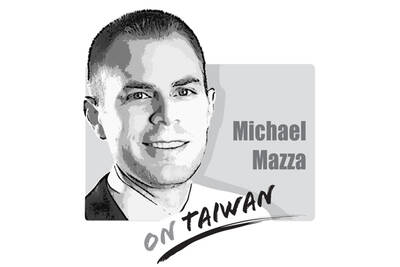The fire that damaged the National Taiwan University’s (NTU) Japanese-style wooden dormitory on Taipei’s Heping E Road early yesterday morning stands as a sharp reminder as to how little attention and care is given to the maintenance and preservation of the nation’s many historic buildings.
Although the blaze was put out in time, sparing the nearby residence of late philosophy professor and democracy pioneer Yin Hai-guang (殷海光), the close call has many historians and concerned parties anxious over the damage that might have occurred to the historical structure and the valuable documents archived at the historical site that once housed the nation’s premier liberalist, who made a significant and long-lasting contribution to the development of liberalism in the country.
Despite a denial from NTU secretary-general Chang Pei-jen (張培仁), the blaze, reported at 12:24am, has raised some eyebrows amid rumors that developers have been eyeing the plot for a development project.
While police, who have not ruled out arson, investigate the cause of the fire, relevant government agencies should take a more active role to better preserve and care for the nation’s many old buildings and landmarks that are rich in Taiwanese culture and history.
The public has good reason to be worried, considering the slew of news reports that suggest cultural and historical sites are being pushed aside to make way for development.
Last month, New Taipei City’s (新北市) Yingge District (鶯歌) — known as the birthplace of the nation’s pottery and ceramics industry — saw a 90-year-old oval-shaped kiln and its smokestack knocked down by a construction company, which owns the site, as well as another square-shaped kiln and its brick-built chimney that had stood for more than 50 years. The area, once dotted with more than 300 high-rise kiln smokestacks, is now left with fewer than a score of them.
Reports of similar demolitions of buildings and houses with historical value have also shocked and saddened many local residents, historians and cultural preservationists, as in the case of demolitions of Japanese colonial era kilns carried out by the Miaoli County Government for urban development projects and in Taichung, where a 114-year-old house was torn down by excavators in the middle of the night.
Sporadic cases of historical houses consumed by fire have also occurred, the causes of which remain unsolved to this day.
The list of enduring landmarks and historical buildings that became rubble because of negligence by management agencies has many wondering how long the government is going to sit idly by while more of the nation’s collective history and priceless local heritage are wiped from the face of the Earth.
No one says it is an easy task tackling the dilemma of development versus preservation. However, the lack of importance the government attaches to the nation’s valuable historical sites is demonstrated by the ineffective laws on preservation and caring for their maintenance. It appears preservation almost always ends up on the losing side.
Taiwanese historical culture must be preserved so that future generations will be able to appreciate it.
The saga of Sarah Dzafce, the disgraced former Miss Finland, is far more significant than a mere beauty pageant controversy. It serves as a potent and painful contemporary lesson in global cultural ethics and the absolute necessity of racial respect. Her public career was instantly pulverized not by a lapse in judgement, but by a deliberate act of racial hostility, the flames of which swiftly encircled the globe. The offensive action was simple, yet profoundly provocative: a 15-second video in which Dzafce performed the infamous “slanted eyes” gesture — a crude, historically loaded caricature of East Asian features used in Western

Is a new foreign partner for Taiwan emerging in the Middle East? Last week, Taiwanese media reported that Deputy Minister of Foreign Affairs Francois Wu (吳志中) secretly visited Israel, a country with whom Taiwan has long shared unofficial relations but which has approached those relations cautiously. In the wake of China’s implicit but clear support for Hamas and Iran in the wake of the October 2023 assault on Israel, Jerusalem’s calculus may be changing. Both small countries facing literal existential threats, Israel and Taiwan have much to gain from closer ties. In his recent op-ed for the Washington Post, President William
A stabbing attack inside and near two busy Taipei MRT stations on Friday evening shocked the nation and made headlines in many foreign and local news media, as such indiscriminate attacks are rare in Taiwan. Four people died, including the 27-year-old suspect, and 11 people sustained injuries. At Taipei Main Station, the suspect threw smoke grenades near two exits and fatally stabbed one person who tried to stop him. He later made his way to Eslite Spectrum Nanxi department store near Zhongshan MRT Station, where he threw more smoke grenades and fatally stabbed a person on a scooter by the roadside.
Taiwan-India relations appear to have been put on the back burner this year, including on Taiwan’s side. Geopolitical pressures have compelled both countries to recalibrate their priorities, even as their core security challenges remain unchanged. However, what is striking is the visible decline in the attention India once received from Taiwan. The absence of the annual Diwali celebrations for the Indian community and the lack of a commemoration marking the 30-year anniversary of the representative offices, the India Taipei Association and the Taipei Economic and Cultural Center, speak volumes and raise serious questions about whether Taiwan still has a coherent India